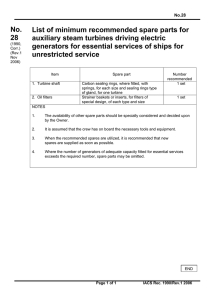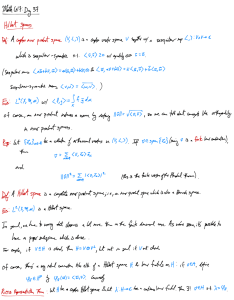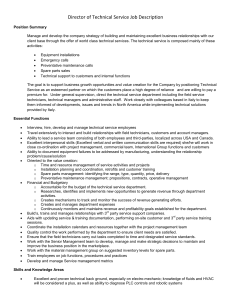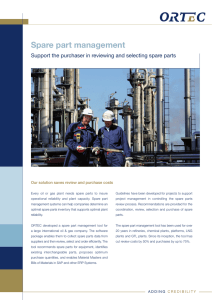Spare-Cell-Aware Multilevel Analytical Placement
advertisement
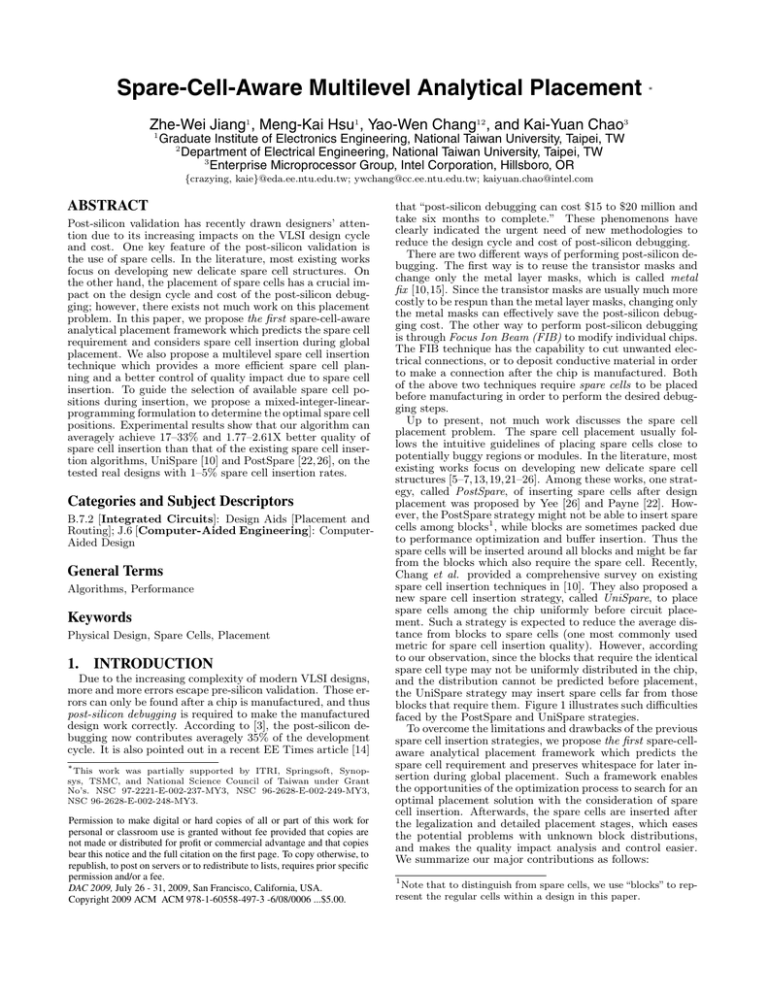
Spare-Cell-Aware Multilevel Analytical Placement
∗
Zhe-Wei Jiang1 , Meng-Kai Hsu1 , Yao-Wen Chang12 , and Kai-Yuan Chao3
1
Graduate Institute of Electronics Engineering, National Taiwan University, Taipei, TW
2
Department of Electrical Engineering, National Taiwan University, Taipei, TW
3
Enterprise Microprocessor Group, Intel Corporation, Hillsboro, OR
{crazying, kaie}@eda.ee.ntu.edu.tw; ywchang@cc.ee.ntu.edu.tw; kaiyuan.chao@intel.com
ABSTRACT
Post-silicon validation has recently drawn designers’ attention due to its increasing impacts on the VLSI design cycle
and cost. One key feature of the post-silicon validation is
the use of spare cells. In the literature, most existing works
focus on developing new delicate spare cell structures. On
the other hand, the placement of spare cells has a crucial impact on the design cycle and cost of the post-silicon debugging; however, there exists not much work on this placement
problem. In this paper, we propose the first spare-cell-aware
analytical placement framework which predicts the spare cell
requirement and considers spare cell insertion during global
placement. We also propose a multilevel spare cell insertion
technique which provides a more efficient spare cell planning and a better control of quality impact due to spare cell
insertion. To guide the selection of available spare cell positions during insertion, we propose a mixed-integer-linearprogramming formulation to determine the optimal spare cell
positions. Experimental results show that our algorithm can
averagely achieve 17–33% and 1.77–2.61X better quality of
spare cell insertion than that of the existing spare cell insertion algorithms, UniSpare [10] and PostSpare [22,26], on the
tested real designs with 1–5% spare cell insertion rates.
Categories and Subject Descriptors
B.7.2 [Integrated Circuits]: Design Aids [Placement and
Routing]; J.6 [Computer-Aided Engineering]: ComputerAided Design
General Terms
Algorithms, Performance
Keywords
Physical Design, Spare Cells, Placement
1. INTRODUCTION
Due to the increasing complexity of modern VLSI designs,
more and more errors escape pre-silicon validation. Those errors can only be found after a chip is manufactured, and thus
post-silicon debugging is required to make the manufactured
design work correctly. According to [3], the post-silicon debugging now contributes averagely 35% of the development
cycle. It is also pointed out in a recent EE Times article [14]
∗
This work was partially supported by ITRI, Springsoft, Synopsys, TSMC, and National Science Council of Taiwan under Grant
No’s. NSC 97-2221-E-002-237-MY3, NSC 96-2628-E-002-249-MY3,
NSC 96-2628-E-002-248-MY3.
Permission to make digital or hard copies of all or part of this work for
personal or classroom use is granted without fee provided that copies are
not made or distributed for profit or commercial advantage and that copies
bear this notice and the full citation on the first page. To copy otherwise, to
republish, to post on servers or to redistribute to lists, requires prior specific
permission and/or a fee.
DAC 2009, July 26 - 31, 2009, San Francisco, California, USA.
Copyright 2009 ACM ACM 978-1-60558-497-3 -6/08/0006 ...$5.00.
that “post-silicon debugging can cost $15 to $20 million and
take six months to complete.” These phenomenons have
clearly indicated the urgent need of new methodologies to
reduce the design cycle and cost of post-silicon debugging.
There are two different ways of performing post-silicon debugging. The first way is to reuse the transistor masks and
change only the metal layer masks, which is called metal
fix [10,15]. Since the transistor masks are usually much more
costly to be respun than the metal layer masks, changing only
the metal masks can effectively save the post-silicon debugging cost. The other way to perform post-silicon debugging
is through Focus Ion Beam (FIB) to modify individual chips.
The FIB technique has the capability to cut unwanted electrical connections, or to deposit conductive material in order
to make a connection after the chip is manufactured. Both
of the above two techniques require spare cells to be placed
before manufacturing in order to perform the desired debugging steps.
Up to present, not much work discusses the spare cell
placement problem. The spare cell placement usually follows the intuitive guidelines of placing spare cells close to
potentially buggy regions or modules. In the literature, most
existing works focus on developing new delicate spare cell
structures [5–7,13,19,21–26]. Among these works, one strategy, called PostSpare, of inserting spare cells after design
placement was proposed by Yee [26] and Payne [22]. However, the PostSpare strategy might not be able to insert spare
cells among blocks1 , while blocks are sometimes packed due
to performance optimization and buffer insertion. Thus the
spare cells will be inserted around all blocks and might be far
from the blocks which also require the spare cell. Recently,
Chang et al. provided a comprehensive survey on existing
spare cell insertion techniques in [10]. They also proposed a
new spare cell insertion strategy, called UniSpare, to place
spare cells among the chip uniformly before circuit placement. Such a strategy is expected to reduce the average distance from blocks to spare cells (one most commonly used
metric for spare cell insertion quality). However, according
to our observation, since the blocks that require the identical
spare cell type may not be uniformly distributed in the chip,
and the distribution cannot be predicted before placement,
the UniSpare strategy may insert spare cells far from those
blocks that require them. Figure 1 illustrates such difficulties
faced by the PostSpare and UniSpare strategies.
To overcome the limitations and drawbacks of the previous
spare cell insertion strategies, we propose the first spare-cellaware analytical placement framework which predicts the
spare cell requirement and preserves whitespace for later insertion during global placement. Such a framework enables
the opportunities of the optimization process to search for an
optimal placement solution with the consideration of spare
cell insertion. Afterwards, the spare cells are inserted after
the legalization and detailed placement stages, which eases
the potential problems with unknown block distributions,
and makes the quality impact analysis and control easier.
We summarize our major contributions as follows:
1
Note that to distinguish from spare cells, we use “blocks” to represent the regular cells within a design in this paper.
Bug-free block
Spare cell
Potentially-buggy block
We summarize the notations used to explain this framework
in Figure 2.
x i , yi
w b , hb
Pb
Db
Mb
tdensity
(a)
(b)
(c)
Figure 1: Illustration of existing spare cell insertion strategies. The blocks and spare cells with
the identical size are of the identical type. (a) The
original placement without spare cell insertion. (b)
The PostSpare strategy places spare cells around
the packed blocks, but the inserted spare cells are
far from the central blocks within the placement region. (c) The UniSpare strategy inserts spare cells
between blocks, but the inserted spare cells may be
far from those blocks which require them, due to the
lack of block distribution information.
• This is the first work in the literature to consider the
spare cell insertion within the analytical placement framework. The proposed cluster expansion and density constraint determination can effectively preserve whitespace during global placement for later spare cell insertion.
• This paper proposes a multilevel spare cell insertion
technique, which provides a more efficient spare cell
planning according to known block distribution and
gives a better control of quality impact due to spare
cell insertion.
• We propose a mixed-integer-linear-programming formulation to determine the optimal spare cell positions
with known block positions. Those optimal positions
can provide a good guidance for the selection of available spare cell positions during spare cell insertion.
The remainder of this paper is organized as follows. Section 2 reviews the analytical placement framework used in
this paper. The proposed spare-cell-aware global placement
techniques and multilevel spare cell insertion are explained
in Section 3. Section 4 reports the experimental results. Finally, the conclusions are given in Section 5.
2. REVIEW ON THE ANALYTICAL PLACEMENT FRAMEWORK
The circuit placement problem can be formulated as a
hypergraph H = (V, E) placement problem. Let vertices
V = {v1 , v2 , ..., vn } represent blocks and hyperedges E =
{e1 , e2 , ..., em } represent nets. Let xi and yi be the respective x and y coordinates of the center of block vi . The circuit
may contain some preplaced blocks which have fixed x and
y coordinates and cannot be moved. We intend to determine the optimal positions of movable blocks so that the
total wirelength is minimized, and there is no overlap among
blocks. The placement problem is usually solved in three
stages, (1) global placement, (2) legalization, and (3) detailed placement. Global placement evenly distributes the
blocks and finds the best position for each block to minimize
the target cost (e.g., wirelength). Then, legalization removes
all overlaps. Finally, detailed placement refines the solution.
center coordinate of block vi
width and height of bin b
base potential (area of preplaced blocks) in bin b
potential (area of movable blocks) in bin b
the maximum potential in bin b
target placement density
Figure 2: Notation used in this paper.
To evenly distribute the blocks, we divide the placement
region into uniform non-overlapping bin grids. Then, the
global placement problem can be formulated as a constrained
minimization problem as follows:
min
s.t.
W (x, y)
Db (x, y) ≤ Mb ,
for each bin b,
(1)
where W (x, y) is the wirelength function, Db (x, y) is the
potential function that is the total area of movable blocks
in bin b, and Mb is the maximum allowable area of movable
blocks in bin b. Mb can be computed by Mb = tdensity (wb hb −
Pb ), where tdensity is a user-specified target density value for
each bin, wb (hb ) is the width (height) of bin b, and Pb is the
base potential that equals the preplaced block area in bin b.
Note that Mb is a fixed value as long as all preplaced block
positions are given and the bin size is determined.
The wirelength W (x, y) is defined as the total half-perimeter
wirelength (HPWL). Since W (x, y) is not smooth and nonconvex, it is hard to minimize it directly. Thus, several
smooth wirelength approximation functions are proposed,
such as quadratic wirelength [12,18], Lp -norm wirelength [9,
17], and log-sum-exp wirelength [8, 16, 20]. The log-sum-exp
wirelength model,
γ
(log
exp(xk /γ) + log
exp(−xk /γ) +
e∈E
vk ∈e
log
vk ∈e
exp(yk /γ) + log
vk ∈e
exp(−yk /γ)),
(2)
vk ∈e
proposed in [20], achieves the best result among these three
models [9]. When γ is small, log-sum-exp wirelength is close
to the HPWL [20].
Since density Db (x, y) is neither smooth nor differentiable,
mPL [9] uses inverse Laplace transformation to smooth the
density, while APlace [16] and NTUplace3 [11] use the bellshaped function for each block to smooth the
density. We express the function Db (x, y) as Db (x, y) = v∈V Px (b, v)Py (b, v),
where Px and Py are the overlap functions of bin b and block
v along the x and y directions. In this paper, we adopt the
bell-shaped potential function [16] px to smooth Px . By doing so, the non-smooth function Db (x, y) can be replaced
by a smooth one, D̂b (x, y) = n
v∈V cv px (b, v)py (b, v), where
cv is a normalization factor so that the total potential of a
block equals its area. Besides, in order to reduce the “valleys”
generated by the bell-shaped function, we use the Gaussian
function to further smooth the base potential [11].
The quadratic penalty method is used to solve Equation (1),
implying that we solve a sequence of unconstrained minimization problems of the form
min W (x, y) + λ
(D̂b (x, y) − Mb )2
(3)
b
with increasing λ’s. The solution of the previous problem
is used as the initial solution for the next one. We solve
the unconstrained problem in Equation (3) by the conjugate
gradient (CG) method. Further, we apply the dynamic step
size approach in [11] to speed up the process of minimizing
Equation (3).
3. MULTILEVEL SPARE-CELL-AWARE
PLACEMENT
In this paper, we propose the spare-cell-aware multilevel
analytical placement. Figure 3 summarizes the flow chart of
the proposed algorithm extended from the analytical placement framework introduced in Section 2. Note that due to
the increasing complexity of modern circuit designs, the multilevel framework is usually applied on the analytical placement to improve the scalability. Since in the upper level of
global placement, blocks are grouped into clusters, we propose the cluster expansion to provide a rougher prediction of
spare cell insertion to each cluster before solving the analytical placement formulation. Then in the finest level of global
placement, with known block distribution, we propose the
density constraint determination to transform the spare cell
requirement into density constraints, which achieves a more
accurate whitespace preservation for spare cell insertion. Finally, after legalization and detailed placement, the multilevel spare cell insertion is proposed to insert spare cells to
near-block and less-quality-impact positions. In this section,
we will introduce the details of all proposed techniques.
the number of blocks is reduced significantly.
After clustering, the analytical placement problem is solved
by the conjugate gradient method at each level of the uncoarsening stage. However, since in the uncoarsening stage,
each cluster contains multiple movable blocks, and the exact placement within the cluster remains unknown, it is relatively hard to preserve whitespace for individual blocks within
each cluster directly. Therefore, in the upper level of uncoarsening, we evaluate the total area of the spare cell requirement for each cluster, and attach the area to the corresponding cluster when solving the analytical placement formulation.
In most cases, the spare cell requirement is determined
according to designers’ experience. The requirement can be
specified by the number or the insertion rate of each type
of spare cells. Without loss of generality, in this paper, we
adopt the insertion rate to represent the spare cell requirement. Let rk represents the given required insertion rate of
spare cells of type tk . For a block vi , let T (vi ) represent
its required spare cell type, and R(vi ) represent the required
insertion rate of T (vi ); in other words, if the required spare
cell type of vi is tk , then T (vi ) = tk and R(vi ) = rk . Let
Area(tk ) represent the area of the spare cell of type tk . For a
cluster C, its required area Areas (C) for spare cell insertion
can be computed by
Areas (C) =
Netlist
Global
Placement
The Finest
Level?
Cluster Expansion
R(vi ) × Area(T (vi )).
(4)
vi ∈C
Next Level
No
Yes
Density Constraint
Determination
Placement
3.2
Placement
Meet
Requirement?
End of Global Placement
Then when solving the analytical placement formulation (Equation (1)) for the current level, Areas (C) is attached to cluster
C when computing the potential function Db (x, y). By doing so, we can preserve the whitespace for spare cell insertion
during the upper levels of uncoarsening, and thus give the
global placement engine more chance to optimize its objectives with the consideration of spare cell insertion.
No
Yes
Legalization
Detailed Placement
Multilevel Spare Cell Insertion
Placed Result
Figure 3: The proposed flow of our spare-cell-aware
multilevel analytical placement.
3.1 Cluster Expansion
The multilevel framework applies a two-stage technique of
bottom-up coarsening followed by top-down uncoarsening.
During the coarsening stage, the blocks are clustered level
by level to reduce the number of movable blocks. There
have been many famous clustering techniques proposed in
the literature, e.g., the best-choice clustering [4] and the firstchoice clustering [9]. The clustering process continues until
Density-Constraint Determination
When the uncoarsening stage reaches the finest level, the
optimization process of the analytical placement framework
is directly applied on blocks of the circuit instead of clusters. Therefore, with known block positions, we can now
provide a more accurate spare cell prediction to the global
placement engine. Since the density constraints give a better control of whitespace than expanding block sizes, in the
finest level, we propose to transform the spare cell requirement into the density constraints in Equation (1) to further
plan the whitespace during global placement.
In the analytical placement framework reviewed in Section 2, the potential function Db (x, y) and the maximum allowable potential Mb are determined according to pre-divided
uniform non-overlapping bins. To preserve whitespace for
spare cell insertion through density constraints, we need to
modify Mb for each bin according to its spare cell requirement. Similar to the cluster expansion technique, each block
will contribute the required area for spare cell insertion to
the corresponding bins, which is proportional to the overlapping area between the block and the bin. For a density bin
b, its required area Areas (b) for spare cell insertion can be
written as
Areas (b) =
vi ∈V
R(vi ) × Area(T (vi )) ×
Ox (vi , b) × Oy (vi , b)
,
Area(vi )
(5)
where Ox (vi , b) and Oy (vi , b) are the amounts of the overlaps between block vi and bin b along the x and y directions,
respectively, and Area(vi ) is the area of block vi . Then the
maximum allowable potential M̂b with the spare cell consid-
eration can be updated by M̂b = Mb − Areas (b), and the
analytical placement formulation will be transformed to
min
s.t.
W (x, y)
Db (x, y) ≤ M̂b
for each bin b.
(6)
Solving this formulation can thus preserve whitespace for
spare cell insertion. Note that this update for the maximum
allowable potential will be performed several times during
the conjugate gradient optimization process to monitor the
block position change and provide a more accurate prediction
of spare cell insertion.
3.3 Multilevel Spare Cell Insertion
Since the spare cell insertion always desires as less impact
on the placement quality as possible, the spare cell insertion
should therefore be performed after the placement is legalized and fully optimized, which eases the potential problems
with unknown block distributions, and makes the quality impact analysis and control easier. Further, because the spare
cell requirement may not uniformly distribute within the chip
boundary, a whole-chip analysis is required to determine an
efficient spare cell planning. Therefore, in this paper, we
propose a multilevel spare cell insertion technique which provides a more efficient spare cell planning according to known
block distribution and a better control of quality impact due
to spare cell insertion.
For each given insertion rate rk of spare cell type tk , the
total number of required spare cells of type tk can be easily
computed by the total number of blocks that require spare
cells of type tk multiplied by rk . After obtaining the required
number of spare cells, we recursively partition the placement
region into uniform sub-regions. Each time the partitioning
is performed, the required number of spare cells is also divided and assigned to two sub-regions in proportion to the
number of blocks belonging to each sub-region that require
spare cells of type tk . Such an allocation strategy can make
sure that the spare cell distribution will be similar to the
block distribution. A slicing tree is constructed at the same
time to record the cut directions and the number of spare
cells assigned to each sub-region. The recursive partitioning
process continues until the sub-region is small enough or the
number of assigned spare cells to this sub-region equals 0 or
1.
After the construction of the partitions and the slicing
tree, we insert the spare cells in a bottom-up fashion. For
each sub-region located in the leaf of the slicing tree, we
first compute the optimal position for each inserted spare
cell according to the blocks that require spare cells of type
tk . Then each row within this sub-region is explored to find
available spare cell positions with their quality impacts under
a given threshold. Then to achieve a lower average distance
from blocks to spare cells, those positions are chosen in an
increasing order of the minimum distance to the optimal positions. If some spare cells fail to be inserted within this
sub-region, they are reserved and will be inserted again in
the upper level of the slicing tree within the union region of
this sub-region and those corresponding to its siblings.
Figure 4 gives an example of the multilevel spare cell insertion. Figure 4(a) shows the initial partitions and the block
distribution within each partition. Figure 4(b) illustrates
the allocation process along the slicing tree. Assume that
there are 10 spare cells of type tk to be inserted in this region. In the root of the slicing tree, the number of allocated
spare cells is divided to 7 and 3 because the two sub-regions
contain 35 and 15 blocks that require spare cells of type tk
respectively. The partitioning process continues to allocate
spare cells into all sub-regions. Note that the recursive partitioning stops at sub-region G since only one spare cell is
allocated in G. Figure 4(c) illustrates the bottom-up spare
cell insertion process. All spare cells are inserted into their
assigned sub-regions. However, in this example, one spare
cell failed to be inserted in sub-region A, and another spare
cell failed to be inserted in sub-region D. They are reserved
and will be inserted into the union of sub-regions A and B
and the union of sub-regions C and D respectively, as shown
in Figure 4(d).
Top-down
p
spare
p cell
allocation
10
A
10
B
5
C
10
D
10
E
5
F
5
7
3
G
5
Bottom-up spare cell
insertion
0
0
2
1
0
G
1
Spare cells failed to be
inserted will be inserted in
the upper level
0
1
4
A BC DE F
2 1 2 2 1 1
(b)
(a)
1
3
0
A BC DE F G
1 1 1 2 1 1 1
A
1 1
B
1
C1
1
D
2
(c)
E
1
F
1
G
1
(d)
Figure 4: (a) Number of blocks that require spare
cells of type tk in each sub-region. (b) Illustration
of the top-down spare cell allocation. The numbers
on the tree nodes indicate the amounts of assigned
spare cells. (c)(d) Bottom-up spare cell insertion.
Spare cells will be inserted in an upper level on the
slicing tree if there is no available position in their
corresponding sub-region.
3.4
Determination of Optimal Spare Cell Positions
The optimal positions that minimize the average distance
from blocks to spare cells can provide a good guidance for
the selection of available spare cell positions in our multilevel
spare cell insertion. For a sub-region that contains exactly
one spare cell, its optimal position is at the gravity center
of all blocks that require it. However, when a sub-region
contains more than one spare cells, the determination of the
optimal spare cell positions becomes much more complex.
For a given sub-region, let VP represent the set of blocks
in this sub-region that require spare cells of type tk , and S
represent the set of to-be-inserted spare cells of the same
type. For a block vp ∈ VP and a spare cell sq ∈ S, their
distance is represented by d(vp , sq ). Then, with the objective
of minimizing the average distance from placed blocks to
spare cells, the determination of optimal spare cell positions
can be formulated as
min
(
VP
dmin
)/|VP |
p
= minS d(vp , sq ), ∀vp ∈ VP ,
s.t. dmin
p
where dmin
represents the distance from block vp to its closp
est spare cell, and |VP | denotes the size of set VP . However,
it is hard to solve such a formulation directly, since it tries
to minimize the minimum of functions.
To cope with such difficulty, we introduce a binary variable
γp,q for each pair of (vp , sq ). If γp,q is set to 1, it means that
the closest spare cell for block vp is sq . We can then rewrite
the formulation as follows:
min
(
VP
dmin
)/|VP |
p
s.t. dmin
d(vp , sq ) + (γp,q − 1) · Dmax , ∀p, q
p
q γp,q = 1, ∀p
where Dmax is a constant representing the maximum possible distance from blocks to spare cells, and is set to the
summation of the width and height of the given sub-region.
For each block vp , the inequality (8) constrains that exactly
one γp,q will be set to 1. Then in inequality (7), the chosen
is greater or equal to the choγp,q will constrain that dmin
p
sen d(vp , sq ), while others with value 0 make no influence on
, because Dmax is always larger or equal to d(vp , sq ).
dmin
p
Since our objective tends to minimize dmin
, the assignment
p
of γp,q ’s will tend to select the closet spare cell sp for each
block vp , which makes dmin
equal to the exact minimum disp
tance from block vp to all spare cells. Such a formulation can
be solved by mixed integer linear programming (MILP), and
has the capability to find the optimal spare cell positions and
the closest spare cell assignment at the same time. Since the
sub-regions are usually small and contain few spare cells, say
less than 5 in practice, at the leaf nodes of the constructed
slicing tree by the multilevel spare cell insertion, the optimal
spare cell positions can thus be determined within reasonable
running time.
4. EXPERIMENTAL RESULTS
We conducted several experiments to justify the effectiveness of the proposed method. Our algorithm has been integrated into NTUplace3 [11], which is a leading academic
placer for the large-scale mixed-size designs and is available
to the public. It should be noted that the proposed algorithm
is very flexible and can also be integrated into other placers
that are based on a similar framework introduced in Section 2
with slight modifications. We compare our proposed spare
cell insertion algorithm with two previously proposed ones,
PostSpare [22, 26] and UniSpare [10]. We also integrated
both algorithms into NTUplace3. All the experiments were
performed on the same PC workstation with eight Intel Xeon
2.5 GHz CPUs and 26 GB memory. To demonstrate the effects of the spare cell insertion on real designs, we picked nine
largest OpenCores [2] circuits in the IWLS 2005 benchmark
suite [1]. The benchmark statistics are given in Table 1.
Table 1: Statistics of the OpenCores circuits used in
this paper.
#Movs
11855
20795
98341
46771
11440
16816
12808
124031
29034
#Nets
11947
21055
98576
46889
11560
16989
12967
124133
30165
Util
(%)
70.01
70.01
70.01
70.01
70.03
70.02
70.01
70.01
70.01
Quality Comparison of Spare Cell Insertion
To demonstrate the effectiveness of our proposed algorithm, we compare the quality of spare cell insertion in this
experiment. One most commonly used metric to measure the
quality of spare cell insertion is the average spare distance.
Let dmin (vi , tk ) represent the minimum distance from block
vi to spare cells of type tk . Then the average spare distance
davg for a placement solution can be computed by
(7)
(8)
γp,q ∈ {0, 1}, ∀p, q,
Circuit
Name
ac97 ctrl
aes core
des perf
ethernet
mem ctrl
pci bridge32
usb funct
vga lcd
wb conmax
4.1
davg =
vi ∈V
dmin (vi , T (vi ))
|V |
,
(9)
where |V | indicates the total number of blocks in this circuit. Table 2 reports the average spare distances of all three
compared spare cell insertion algorithms for 1–5% spare cell
insertion rates. We list the exact values of davg of our proposed algorithm, and for the UniSpare and PostSpare algorithms, we list the ratios of their davg to that of our algorithm. Among all tested insertion rates, our algorithm can
consistently achieve 17–33% better average davg than UniSpare due to its lack of block distribution information before
placement, while our algorithm applies the multilevel spare
cell insertion to place spare cells close to blocks that require
them. Compared with PostSpare, since it can hardly insert spare cells between packed blocks without pre-allocated
whitespace, the average spare distance davg of PostSpare is
about 1.77–2.61X worse than that of our algorithm.
4.2
HPWL Comparison after Spare Cell Insertion
In this experiment, we compare the HPWL degradation
due to spare cell insertion for each algorithm. Table 3 lists
the HPWLs for NTUplace3 without spare cell insertion, and
the ratios of the HPWLs for our algorithm and UniSpare to
those of NTUplace3, among 1–5% spare cell insertion rates.
Note that the results of PostSpare are not listed here since
its HPWLs are all the same with those of NTUplace3, and
its average spare distance davg is much worse than that of
our algorithm and UniSpare. Since the spare cell insertion
methods for our algorithm and UniSpare add extra cells between the placed blocks, they often induce HPWL overheads
in order to improve the quality of spare cell insertion2 . Under the identical spare cell insertion rate, since UniSpare
distributes spare cells uniformly into the chip, part of the
spare cells will be placed far from the placed blocks. Therefore, the number of spare cells inserted between blocks of
UniSpare should be less than that of our algorithm, which
inserts all spare cells between placed blocks. Consequently,
the HPWL overhead of UniSpare should be less than that of
our algorithm. However, according to Table 3, the average
HPWL overhead of our algorithm (ranges from 2% to 4%)
is always less or equal to that of UniSpare (ranges from 3%
to 5%) among all tested insertion rates. Such a phenomenon
implies that our proposed spare-cell-aware analytical placement framework provides accurate spare cell prediction, and
thus enables the opportunities of the global placement engine to optimize its original objectives with the additional
consideration of spare cell insertion.
5.
CONCLUSIONS
In this paper, we have proposed the first spare-cell-aware
analytical placement framework. A multilevel spare cell in2
Due to the unstability of the nonlinear analytical placement formulation, NTUplace3 may sometimes find a slightly better HPWL
placement solution with the existence of pre-placed spare cells
from UniSpare, or with the use of cluster expansion and density
constraint determination for our algorithm.
Table 2: The comparison of the average spare distance (davg ).
Circuit
Name
ac97 ctrl
aes core
des perf
ethernet
mem ctrl
pci bridge32
usb funct
vga lcd
wb conmax
average
1% Insertion Rate
UniPostOurs
Spare Spare
davg
(×105 ) Ratio Ratio
2.94
1.33
1.87
2.50
1.32
2.23
3.26
1.17
3.29
2.91
1.30
3.19
2.93
1.31
1.90
3.06
1.26
2.27
3.01
1.28
2.06
3.40
1.07
4.82
2.16
1.88
3.29
1.33
2.77
2% Insertion Rate
UniPostOurs
Spare Spare
davg
(×105 ) Ratio Ratio
2.05
1.30
2.23
1.75
1.30
2.71
2.22
1.23
4.15
2.18
1.30
3.54
2.24
1.31
2.35
2.14
1.32
2.61
2.17
1.19
2.50
2.74
0.96
5.33
1.53
1.37
3.78
1.25
3.24
3% Insertion Rate
UniPostOurs
Spare Spare
davg
(×105 ) Ratio Ratio
1.70
1.53
2.43
1.47
1.31
2.80
1.93
1.16
4.47
1.89
1.30
3.61
1.96
1.20
2.40
1.87
1.24
2.51
1.86
1.19
2.75
2.00
1.13
6.77
1.35
1.30
4.37
1.26
3.57
4% Insertion Rate
UniPostOurs
Spare Spare
davg
(×105 ) Ratio Ratio
1.48
1.45
2.60
1.27
1.28
2.88
1.75
1.10
4.88
1.59
1.35
3.85
1.68
1.21
2.92
1.67
1.28
2.57
1.72
1.16
2.92
2.32
0.80
5.49
1.23
1.24
4.03
1.21
3.57
5% Insertion Rate
UniPostOurs
Spare Spare
davg
(×105 ) Ratio Ratio
1.34
1.46
2.81
1.17
1.26
3.16
1.73
0.95
4.69
1.51
1.28
3.80
1.58
1.18
2.87
1.49
1.26
2.71
1.46
1.23
3.31
2.37
0.68
5.05
1.19
1.21
4.08
1.17
3.61
Table 3: The comparison of HPWL ratios.
Circuit
Name
ac97 ctrl
aes core
des perf
ethernet
mem ctrl
pci bridge32
usb funct
vga lcd
wb conmax
average
NTUplace3
HPWL
(×109 )
1.16
1.98
14.08
8.62
1.30
1.86
1.35
29.71
3.21
-
1% Insertion Rate
2% Insertion Rate
3% Insertion Rate
4% Insertion Rate
5% Insertion Rate
Ours
1.02
1.02
1.07
1.01
1.03
1.00
1.03
0.98
1.01
1.02
Ours
1.01
1.04
1.13
1.04
1.03
0.98
1.05
0.97
0.98
1.03
Ours
1.02
1.03
1.10
1.03
1.02
1.02
1.04
0.97
1.02
1.03
Ours
1.02
1.05
1.11
0.97
1.05
1.00
1.06
0.99
1.04
1.03
Ours
1.04
1.03
1.14
0.98
1.04
1.01
1.05
1.03
1.03
1.04
UniSpare
1.02
1.05
1.04
1.04
1.09
0.94
1.05
1.00
1.02
1.03
UniSpare
1.01
1.05
1.05
1.03
1.10
0.96
1.06
1.06
1.02
1.04
sertion technique has also been presented with proven capability of providing an efficient spare cell planning and an
excellent control of quality impact due to spare cell insertion.
To guide the selection of available spare cell positions during insertion, we have also proposed a mixed-integer-linearprogramming formulation to determine the optimal spare
cell positions. Experimental results have shown that our
algorithm can achieve a much better efficiency of spare cell
insertion than existing algorithms with only slight quality
overhead.
[12]
[13]
[14]
[15]
[16]
6. REFERENCES
[1] IWLS 2005 Benchmarks.
http://iwls.org/iwls2005/benchmarks.html.
[2] OpenCores. http://www.opencores.org.
[3] M. Abramovici, P. Bradley, K. Dwarakanath, P. Levin,
G. Memmi, and D. Miller. A reconfigurable design-for-debug
infrastructure for SoCs. In Porc. of DAC, 2006.
[4] C. Alpert, A. Kahng, G.-J. Nam, S. Reda, and P. Villarrubia. A
semi-persistent clustering technique for VLSI circuit placement.
In Proc. of ISPD, pages 200–207, 2005.
[5] C. Bingert, C. D. Gorsuch, O. G. Mercado, A. K. Myers, J. A.
Schadt, and B. W. Yeager. US patent 6,600,341: Integrated
circuit and associated design method using spare gate islands.
2003.
[6] M. Brazell and A. Essbaum. US patent 6,993,738: Method for
allocating spare cells in auto-place-route blocks. 2006.
[7] P. Chaisemartin. US patent 6,586,961: Structure and method of
repair of integrated circuits. 2003.
[8] T. Chan, J. Cong, J. Shinnerl, K. Sze, and M. Xie. mPL6:
Enhanced multilevel mixed-size placement. In Proc. of ISPD,
2006.
[9] T. Chan, J. Cong, and K. Sze. Multilevel generalized
force-directed method for circuit placement. In Proc. of ISPD,
2005.
[10] K.-H. Chang, I. L. Markov, and V. Bertacco. Reap what you
sow: Spare cells for post-silicon metal fix. In Porc. of ISPD,
2008.
[11] T.-C. Chen, Z.-W. Jiang, T.-C. Hsu, H.-C. Chen, and Y.-W.
Chang. NTUplace3: A high-quality mixed-size analytical placer
[17]
[18]
[19]
[20]
[21]
[22]
[23]
[24]
[25]
[26]
UniSpare
0.98
1.06
1.23
0.96
1.11
0.97
1.04
1.02
1.04
1.05
UniSpare
1.02
1.06
1.14
0.98
1.11
0.96
1.04
1.02
1.03
1.04
UniSpare
1.03
1.07
1.05
0.98
1.13
0.95
1.03
1.03
1.05
1.04
considering preplaced blocks and density constraints. In
Proc. of ICCAD, 2006.
H. Eisenmann and F. M. Johannes. Generic global placement
and floorplanning. In Proc. of DAC, 1998.
C. M. Giles. US patent 6,650,139: Modular collection of spare
gates for use in hierarchical integrated circuit design process.
2003.
R. Goering. Post-silicon debugging worth a second look. EE
Times, February 5, 2007.
D. Josephson. The good, the bad, and the ugly of silicon debug.
In Porc. of DAC, 2006.
A. B. Kahng and Q. Wang. Implementation and extensibility of
an analytic placer. IEEE Trans. on CAD, 24(5), 2005.
A. B. Kahng and Q. Wang. A faster implementation of APlace.
In Proc. of ISPD, 2006.
M. Kleinhans, G. Sigl, F. M. Johannes, and K. J. Antreich.
Gordian: VLSI placement by quadratic programming and
slicing optimization. IEEE Trans. on CAD, 10(3), 1991.
D. Lee. US patent 5,696,943: Method and apparatus for quick
and reliable design modification on silicon. 1997.
W. C. Naylor, R. Donelly, and L. Sha. US patent 6,301,693:
Non-linear optimization system and method for wire length and
dealy optimization for an automatic electric circuit placer. 2001.
Z. Or-Bach. US patent 6,756,811 B2: Customizable and
programmable cell array. 2004.
R. L. Payne. US patent 5,959,905: Cell-based integrated circuit
design repair using gate array repair cells. 1999.
J. A. Schadt. US patent 6,404,226 B1: Integrated circuit with
standard cell logic and spare gates. 2002.
A. Vergnes. US patent 6,791,355 B2: Spare cell architecture for
fixing design errors in manufactured integrated circuits. 2004.
J. Wong, D. Chiang, and J. Tolentino. US patent 6,255,845 B1:
Efficient use of spare gates for post-silicon debug and
enhancements. 2001.
C. L. Yee, S. Aji, and S. Rusu. US patent 5,623,420: Method
and apparatus to distribute spare cells within a standard cell
region of an integrated circuit. 1997.

